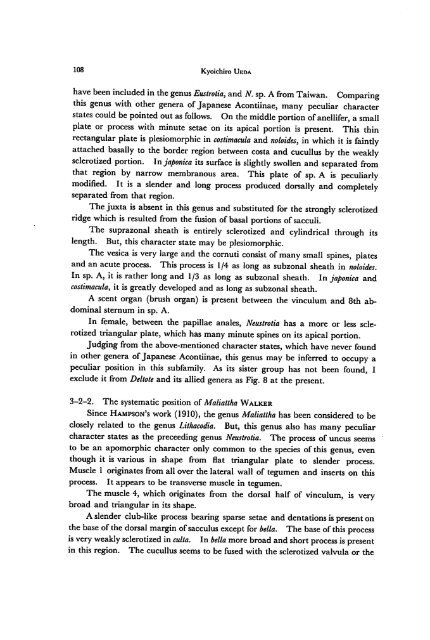A revision of the genus Deltote RL and its allied genera from Japan ...
A revision of the genus Deltote RL and its allied genera from Japan ...
A revision of the genus Deltote RL and its allied genera from Japan ...
Create successful ePaper yourself
Turn your PDF publications into a flip-book with our unique Google optimized e-Paper software.
108 Kyoichiro Ueda<br />
have been included in <strong>the</strong> <strong>genus</strong> Eustrotia, <strong>and</strong> N. sp. A<strong>from</strong> Taiwan. Comparing<br />
this <strong>genus</strong> with o<strong>the</strong>r <strong>genera</strong> <strong>of</strong><strong>Japan</strong>ese Acontiinae, many peculiar character<br />
states could be pointed outas follows. On <strong>the</strong> middle portion <strong>of</strong>anellifer, a small<br />
plate or process with minute setae on <strong>its</strong> apical portion is present. This thin<br />
rectangular plate is plesiomorphic in costimacula <strong>and</strong> noloides, in which it is faintly<br />
attached basally to <strong>the</strong> border region between costa <strong>and</strong> cucullus by <strong>the</strong> weakly<br />
sclerotized portion. Injaponica <strong>its</strong> surface is slightly swollen <strong>and</strong> separated <strong>from</strong><br />
that region by narrow membranous area. This plate <strong>of</strong> sp. A is peculiarly<br />
modified. It is a slender <strong>and</strong> long process produced dorsally <strong>and</strong> completely<br />
separated <strong>from</strong> that region.<br />
The juxta is absent in this <strong>genus</strong> <strong>and</strong> substituted for <strong>the</strong> strongly sclerotized<br />
ridge which is resulted <strong>from</strong> <strong>the</strong> fusion <strong>of</strong>basal portions <strong>of</strong>sacculi.<br />
The suprazonal sheath is entirely sclerotized <strong>and</strong> cylindrical through <strong>its</strong><br />
length. But, this character state may be plesiomorphic.<br />
The vesica is very large <strong>and</strong> <strong>the</strong> cornuti consist <strong>of</strong>many small spines, plates<br />
<strong>and</strong> an acute process. This process is 1/4 as long as subzonal sheath in noloides.<br />
In sp. A, it is ra<strong>the</strong>r long <strong>and</strong> 1/3 as long as subzonal sheath. In japonica <strong>and</strong><br />
costimacula, it is greatly developed <strong>and</strong> as long as subzonal sheath.<br />
A scent organ (brush organ) is present between <strong>the</strong> vinculum <strong>and</strong> 8th ab<br />
dominal sternum in sp. A.<br />
In female, between <strong>the</strong> papillae anales, Neustrotia has a more or less scle<br />
rotized triangular plate, which has many minute spines on<strong>its</strong> apical portion.<br />
Judging <strong>from</strong> <strong>the</strong> above-mentioned character states, which have never found<br />
in o<strong>the</strong>r <strong>genera</strong> <strong>of</strong><strong>Japan</strong>ese Acontiinae, this <strong>genus</strong> may be inferred to occupy a<br />
peculiar position in this subfamily. As <strong>its</strong> sister group has not been found, I<br />
exclude it <strong>from</strong> <strong>Deltote</strong> <strong>and</strong> <strong>its</strong> <strong>allied</strong> <strong>genera</strong> as Fig. 8 at <strong>the</strong> present.<br />
3-2-2. The systematic position <strong>of</strong> Maliattha Walker<br />
Since Hampson's work (1910), <strong>the</strong> <strong>genus</strong> Maliattha has been considered to be<br />
closely related to <strong>the</strong> <strong>genus</strong> Lithacodia. But, this <strong>genus</strong> also has many peculiar<br />
character states as <strong>the</strong> preceeding <strong>genus</strong> Neustrotia. The process <strong>of</strong> uncus seems<br />
to be an apomorphic character only common to <strong>the</strong> species <strong>of</strong>this <strong>genus</strong>, even<br />
though it is various in shape <strong>from</strong> flat triangular plate to slender process.<br />
Muscle 1 originates <strong>from</strong> all over <strong>the</strong>lateral wall <strong>of</strong> tegumen <strong>and</strong> inserts on this<br />
process. It appears to be transverse muscle in tegumen.<br />
The muscle 4, which originates <strong>from</strong> <strong>the</strong> dorsal half <strong>of</strong> vinculum, is very<br />
broad <strong>and</strong> triangular in <strong>its</strong> shape.<br />
Aslender club-like process bearing sparse setae <strong>and</strong> dentations ispresent on<br />
<strong>the</strong>base <strong>of</strong><strong>the</strong>dorsal margin <strong>of</strong>sacculus except for bella. The base <strong>of</strong>this process<br />
isvery weakly sclerotized in culta. In bella more broad <strong>and</strong>short process ispresent<br />
in this region. The cucullus seems to be fused with <strong>the</strong> sclerotized valvula or <strong>the</strong>
















